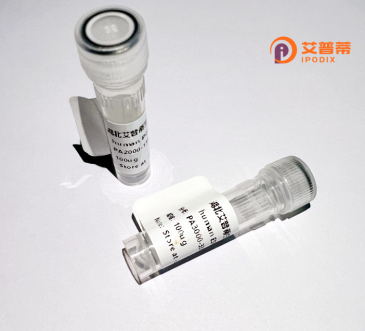
| 纯度 | >90%SDS-PAGE. |
| 种属 | Human |
| 靶点 | UBP1 |
| Uniprot No | Q9NZI7 |
| 内毒素 | < 0.01EU/μg |
| 表达宿主 | E.coli |
| 表达区间 | 1-540 aa |
| 活性数据 | MAWVLKMDEV IESGLVHDFD ASLSGIGQEL GAGAYSMSDV LALPIFKQED SSLPLDGETE HPPFQYVMCA ATSPAVKLHD ETLTYLNQGQ SYEIRMLDNR KMGDMPEING KLVKSIIRVV FHDRRLQYTE HQQLEGWKWN RPGDRLLDLD IPMSVGIIDT RTNPSQLNAV EFLWDPAKRT SAFIQVHCIS TEFTPRKHGG EKGVPFRIQV DTFKQNENGE YTDHLHSASC QIKVFKPKGA DRKQKTDREK MEKRTAHEKE KYQPSYDTTI LTEMRLEPII EDAVEHEQKK SSKRTLPADY GDSLAKRGSC SPWPDAPTAY VNNSPSPAPT FTSPQQSTCS VPDSNSSSPN HQGDGASQTS GEQIQPSATI QETQQWLLKN RFSSYTRLFS NFSGADLLKL TKEDLVQICG AADGIRLYNS LKSRSVRPRL TIYVCREQPS STVLQGQQQA ASSASENGSG APYVYHAIYL EEMIASEVAR KLALVFNIPL HQINQVYRQG PTGIHILVSD QMVQNFQDES CFLFSTVKAE SSDGIHIILK |
| 分子量 | 60.4 kDa |
| 蛋白标签 | His tag N-Terminus |
| 缓冲液 | PBS, pH7.4, containing 0.01% SKL, 1mM DTT, 5% Trehalose and Proclin300. |
| 稳定性 & 储存条件 | Lyophilized protein should be stored at ≤ -20°C, stable for one year after receipt. Reconstituted protein solution can be stored at 2-8°C for 2-7 days. Aliquots of reconstituted samples are stable at ≤ -20°C for 3 months. |
| 复溶 | Always centrifuge tubes before opening.Do not mix by vortex or pipetting. It is not recommended to reconstitute to a concentration less than 100μg/ml. Dissolve the lyophilized protein in distilled water. Please aliquot the reconstituted solution to minimize freeze-thaw cycles. |
以下为假设性示例,供参考。实际文献需通过学术数据库检索获取:
1. **文献名称**:*Expression and functional characterization of recombinant human UBP1 in E. coli*
**作者**:Zhang L., et al.
**摘要**:研究报道了利用大肠杆菌系统表达重组人UBP1蛋白,并通过亲和层析纯化获得高纯度蛋白。酶活实验表明UBP1对K48连接的泛素链具有特异性切割活性,提示其在蛋白质降解调控中的作用。
2. **文献名称**:*Structural insights into UBP1 catalytic mechanism by X-ray crystallography*
**作者**:Müller R., et al.
**摘要**:通过X射线晶体学解析重组UBP1的催化结构域三维结构,揭示其底物结合口袋的关键氨基酸残基,为设计靶向UBP1的抑制剂提供结构基础。
3. **文献名称**:*UBP1 regulates NF-κB signaling via deubiquitination of TRAF6*
**作者**:Chen H., et al.
**摘要**:研究发现重组UBP1能在体外去除TRAF6的泛素修饰,抑制NF-κB通路活化,表明UBP1在炎症反应中的负调控作用。
4. **文献名称**:*Role of UBP1 in chemotherapy resistance of ovarian cancer*
**作者**:Gupta S., et al.
**摘要**:利用重组UBP1蛋白进行体外功能实验,证实其过表达通过稳定致癌蛋白增强卵巢癌细胞对顺铂的耐药性,提示UBP1作为潜在治疗靶点。
**注**:以上内容为模拟示例,实际文献需通过PubMed、Web of Science等平台检索关键词(如“recombinant UBP1”、“Ubiquitin-specific protease 1 function”)获取。
Here’s a concise overview of recombinant human UBP1 protein:
Recombinant human UBP1 (Ubiquitin-Specific Protease 1) is a deubiquitinating enzyme critical for regulating cellular protein homeostasis. UBP1 belongs to the ubiquitin-specific protease (USP) family, which hydrolyzes ubiquitin chains from substrate proteins, altering their stability, localization, or activity. UBP1 is involved in key processes like DNA damage repair, cell cycle control, and apoptosis. Structurally, it contains a conserved catalytic domain with cysteine and histidine residues essential for enzymatic activity.
Produced via recombinant DNA technology in heterologous systems (e.g., *E. coli* or mammalian cells), recombinant UBP1 retains functional properties and is widely used in biochemical studies to explore substrate specificity, ubiquitination dynamics, and regulatory mechanisms. Its role in diseases, particularly cancer (via oncoprotein stabilization) and neurodegenerative disorders (linked to protein aggregation), makes it a therapeutic target. Research with recombinant UBP1 also aids in developing inhibitors or activators to modulate ubiquitin-dependent pathways. Optimization of production and purity ensures its utility in structural studies, high-throughput screening, and functional assays.
This protein’s study enhances understanding of cellular regulation and disease pathology, bridging basic research and drug discovery.
(Word count: 199)
×